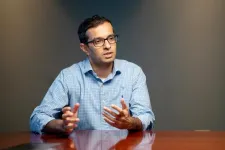(Press-News.org) How do algorithms determine the way we interact with our memories?
It’s a uniquely 21st-century kind of question, and it is far from settled.
In a new paper in the journal Memory, Mind & Media, Concordia PhD candidate Chrys Vilvang argues that the way tech companies store, package and share personal content back to users is opaque. And, given one recent controversy, it’s open to important questions about selection and representation.
Vilvang’s paper looks at the discussion stemming from an April 2022 article on 9to5Mac, a tech news site dedicated to all things Apple. Its journalists were given access to the iOS 15.5 beta update, and they discovered it was blocking photographs from a dozen specific locations from appearing in the iPhone Photos app’s Memories. This is the function that creates short playback albums set to music usually designed to elicit smiles and tug on heartstrings.
The journalists quickly found that the dozen sites were all related to the Holocaust. Several were actual concentration camps, including Auschwitz-Birkenau, Treblinka and Dachau. But others were Holocaust memorial sites such as Yad Vashem in Israel, the Anne Frank House in Amsterdam and the United States Holocaust Memorial Museum in Washington, DC.
Vilvang turned to the article’s comments section to analyze the evolving public perception of automated memory technologies and their potential consequences. 9to5Mac readers are deeply invested in technology matters, and Vilvang was struck by the near universal skepticism of Apple’s decision.
“Most seemed very leery of what this could indicate for the future, or how it could be used to privilege a certain kind of representation,” he says. “But I was impressed by how deeply people were willing to go to express their unique issues with it and how they were willing to speculate what it could indicate, without speaking specifically about the Holocaust.”
My photos, my agency
Vilvang quotes several commenters in his paper, most of whom express annoyance at the removal of their power to decide what they can and cannot see.
“I don’t want someone else deciding what is ‘sensitive’ … and perhaps I WANT a memory of a particularly moving place to keep me grounded,” writes one.
“[Let] people be in charge of their memories,” writes another. “I, for one, have visited Dachau and have shot pictures…. It doesn’t bother me in the slightest when they appear. Quite the opposite, they serve as a powerful reminder.”
Vilvang says he has not heard any comment from Apple regarding the update, but he suspects that it came from a place of good faith.
“The motivation I think is probably well intentioned and probably straightforward: I assume that they did not think that topics that have such a degree of gravity should be represented in a tool that is largely geared toward positive interactions.”
As advanced as technology is today, he adds, Apple’s algorithms still cannot decide what might be subjectively relevant to one individual over another. By trying to keep the Memories function associated with happiness, it is deliberately making choices on its users’ behalf by blocking photos from sites that it deems problematic.
The future for this kind of application remains as murky as its present algorithms, Vilvang adds. If Apple decides to block Holocaust-themed photos, what might it block next?
“This illustrates the degree of intervention and intention that goes into blocking these specific sites for reasons that have not been articulated. And if we know companies are willing to intervene in these kinds of ways, then we need to critically question our own interactions with our past, knowing that it is being mediated by something over which we have no control.”
Read the cited paper: “Between automated memory and history: blocking ‘sensitive locations’ from Apple Memories.”
END
The move by Apple Memories to block potentially upsetting content illustrates Big Tech’s reach and limits, writes Chrys Vilvang
Concordia PhD candidate says an update that excluded photos from sites linked to the Holocaust ignited a debate about our relationships with the past
2024-04-23
ELSE PRESS RELEASES FROM THIS DATE:
Chemical tool illuminates pathways used by dopamine, opioids and other neuronal signals
2024-04-23
Image
University of Michigan researchers have developed a new tool to better understand how chemicals like dopamine and epinephrine interact with neurons.
These chemicals are among a wide variety of signals that get processed in the brain through G protein-coupled receptors (GPCRs), proteins that sit on the surface of neurons to receive messages—in the forms of proteins, sugars, fats, even light—that inform cellular behavior.
GPCRs are involved in an enormous number of biological functions, making them a prime ...
Asian monsoon lofts ozone-depleting substances to stratosphere
2024-04-23
Asian monsoon lofts ozone-depleting substances to stratosphere
Airborne observations discover new link between pollution and climate
Powerful monsoon winds, strengthened by a warming climate, are lofting unexpectedly large quantities of ozone-depleting substances high into the atmosphere over East Asia, new research shows.
The study, led by the U.S. National Science Foundation National Center for Atmospheric Research (NSF NCAR) and NASA, found that the East Asian Monsoon delivers more than twice the concentration of very short-lived ozone-depleting substances into the upper troposphere and lower stratosphere than previously reported.
The research team ...
PET scans reveal ‘smoldering’ inflammation in patients with multiple sclerosis
2024-04-23
A Brigham and Women’s Hospital study of 30 people found that, in patients with MS, advanced brain imaging could identify hidden inflammation not picked up on traditional MRIs
The new technique could lead to more advanced treatments for multiple sclerosis
A new study from Brigham and Women’s Hospital, a founding member of the Mass General Brigham healthcare system, suggests positron emission tomography (PET) brain scans could reveal hidden inflammation in patients with multiple sclerosis (MS) who are being treated with highly-effective treatments. The findings were published ...
Genetics predict type 2 diabetes risk and disparities in childhood cancer survivors
2024-04-23
(MEMPHIS, Tenn. – April 23, 2024) Survivors of childhood cancer are at increased risk for cardiovascular disease, for which a risk factor is their greater prevalence of type 2 diabetes, with a disproportionate impact on those of non-European heritage. St. Jude Children’s Research Hospital scientists have identified four previously unknown genetic variants associated with diabetes risk in all survivors. Published today in the Journal of Clinical Oncology, their work also found an association between a previously ...
Health information on TikTok: The good, the bad and the ugly
2024-04-23
In today's digital age, social media platforms like TikTok have become integral parts of our lives, offering not just entertainment and catchy dances but also a wealth of information on topics ranging from home improvement to world news. According to some reports, many young people even prefer to use social media in place of traditional search engines like Google when looking for answers.
Health information is no exception. Hashtags like #celiactok, #diabetestok and #sinustok have millions of views, with each tag leading to countless videos about each health issue.
“Every type of ‘Tok’ exists – that’s just ...
New study points to racial and social barriers that block treatment for multiple myeloma
2024-04-23
A UC Davis Health study reveals persistent racial and social disparities preventing access to autoHCT, a common bone marrow transplant treatment to halt the progression of multiple myeloma.
An analysis of data from three California health care organizations, published in Clinical Lymphoma, Myeloma & Leukemia, showed that Black myeloma patients were less likely to receive autoHCT. This was despite having a greater risk of developing the cancer than other racial or ethnic groups. Patients using Medicaid, Medicare, or no insurance in California also accessed the treatment less than those with other insurance ...
Rensselaer researcher finds that frog species evolved rapidly in response to road salts
2024-04-23
When we think of evolution, we think of a process that happens over hundreds or thousands of years. In research recently published, a team led by Rick Relyea, Ph.D., professor of biological sciences and David M. Darrin ’40 Senior Endowed Chair at Rensselaer Polytechnic Institute, found a species of frog that has evolved over the course of merely 25 years. The adaptation was spurred on by something many assume is innocuous: salt.
“We’ve been applying de-icing salts to reduce car accidents in snowy and icy conditions in the United States for 80 years, and we currently apply four times more road salt than we did ...
A new chapter in quantum vortices: Customizing electron vortex beams
2024-04-23
A new publication from Opto-Electronic Advances; DOI 10.29026/oea.2024.230184 , discusses tailoring electron vortex beams with customizable intensity patterns by electron diffraction holography.
In recent years, the scientific community has witnessed a notable breakthrough in the study and development of electron vortices. Electron vortices are electron beams that carry orbital angular momentum, meaning the electrons move not only in their propagation direction but also rotate in a vortex-like manner. This unique characteristic offers many new physical properties and potential applications, making it a powerful ...
Don’t be a stranger – study finds rekindling old friendships as scary as making new ones
2024-04-23
sychologists from Simon Fraser University (SFU) and the University of Sussex have found that people are as hesitant to reach out to an old friend as they are to strike up a conversation with a stranger, even when they had the capacity and desire to do so. The new research is published today in the journal Nature Communications Psychology.
Scientific research has shown that social relationships are important to human happiness, and that the greater the number and range of friendships that we engage with, the better our wellbeing. But once relationships are formed, some ...
There’s no ‘one size fits all’ when it comes to addressing men’s health issues globally
2024-04-23
Even with important strides in addressing health issues across the globe, men have not benefited equally compared to women. Men’s life expectancies have not grown as steadily as women’s over the past few decades, and they are expected to live about five years less than women, according to 2021 global health data from the Human Mortality Database and the United Nations’ World Population Prospects. The discrepancy in life expectancy between men and women persists in places all over the world, and is even growing in other places.
At a time when health resources are at a premium and need to be wisely allocated, health professionals ...
LAST 30 PRESS RELEASES:
UVA’s Jundong Li wins ICDM’S 2025 Tao Li Award for data mining, machine learning
UVA’s low-power, high-performance computer power player Mircea Stan earns National Academy of Inventors fellowship
Not playing by the rules: USU researcher explores filamentous algae dynamics in rivers
Do our body clocks influence our risk of dementia?
Anthropologists offer new evidence of bipedalism in long-debated fossil discovery
Safer receipt paper from wood
Dosage-sensitive genes suggest no whole-genome duplications in ancestral angiosperm
First ancient human herpesvirus genomes document their deep history with humans
Why Some Bacteria Survive Antibiotics and How to Stop Them - New study reveals that bacteria can survive antibiotic treatment through two fundamentally different “shutdown modes”
UCLA study links scar healing to dangerous placenta condition
CHANGE-seq-BE finds off-target changes in the genome from base editors
The Journal of Nuclear Medicine Ahead-of-Print Tip Sheet: January 2, 2026
Delayed or absent first dose of measles, mumps, and rubella vaccination
Trends in US preterm birth rates by household income and race and ethnicity
Study identifies potential biomarker linked to progression and brain inflammation in multiple sclerosis
Many mothers in Norway do not show up for postnatal check-ups
Researchers want to find out why quick clay is so unstable
Superradiant spins show teamwork at the quantum scale
Cleveland Clinic Research links tumor bacteria to immunotherapy resistance in head and neck cancer
First Editorial of 2026: Resisting AI slop
Joint ground- and space-based observations reveal Saturn-mass rogue planet
Inheritable genetic variant offers protection against blood cancer risk and progression
Pigs settled Pacific islands alongside early human voyagers
A Coral reef’s daily pulse reshapes microbes in surrounding waters
EAST Tokamak experiments exceed plasma density limit, offering new approach to fusion ignition
Groundbreaking discovery reveals Africa’s oldest cremation pyre and complex ritual practices
First breathing ‘lung-on-chip’ developed using genetically identical cells
How people moved pigs across the Pacific
Interaction of climate change and human activity and its impact on plant diversity in Qinghai-Tibet plateau
From addressing uncertainty to national strategy: an interpretation of Professor Lim Siong Guan’s views
[Press-News.org] The move by Apple Memories to block potentially upsetting content illustrates Big Tech’s reach and limits, writes Chrys VilvangConcordia PhD candidate says an update that excluded photos from sites linked to the Holocaust ignited a debate about our relationships with the past





